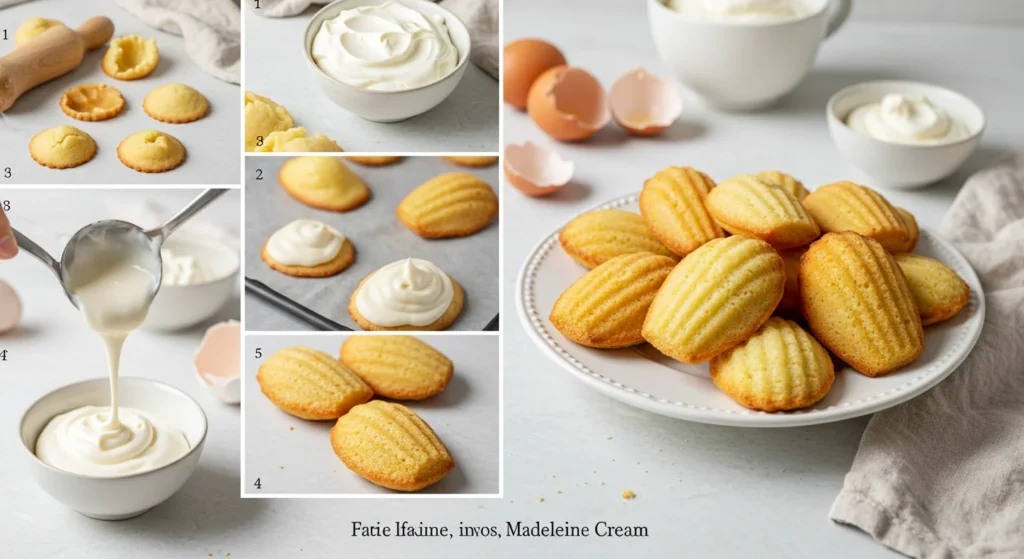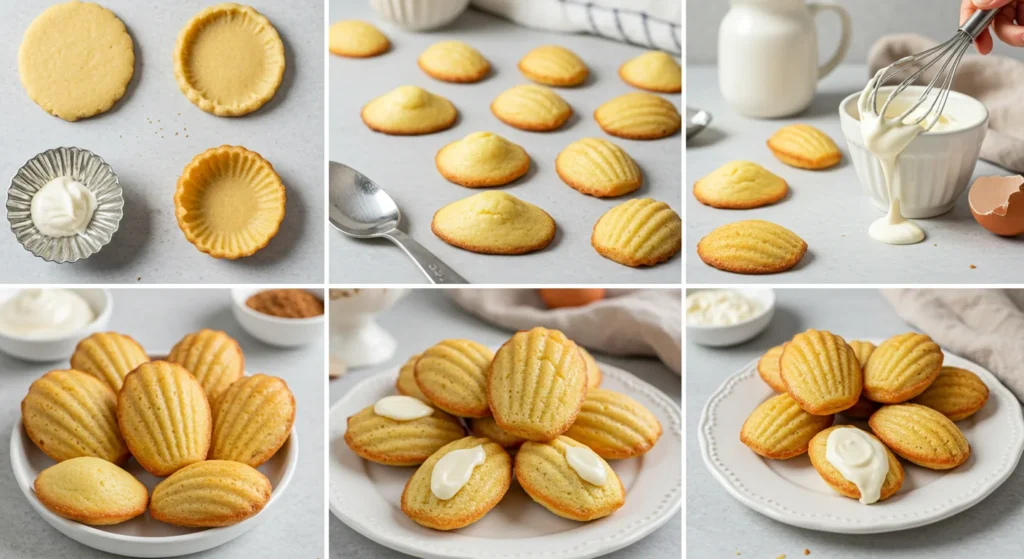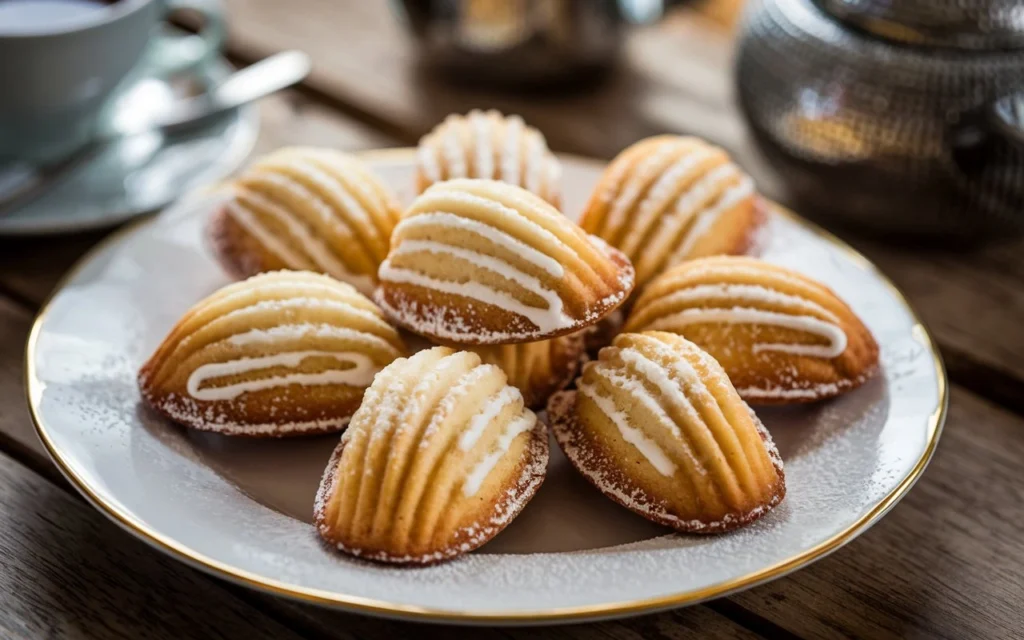Introduction
Madeleine cookies, with their iconic shell-shaped appearance and soft, buttery texture, are a delightful treat for any occasion. Originating from France, these little cakes are as beautiful as they are delicious. But what happens when you add cream to the mix? It’s pure magic! Cream not only adds richness but also elevates the flavor and texture, making them even more irresistible. In this article, you’ll discover how to make the perfect Madeleine cookies recipe using cream, complete with tips, tricks, and flavor variations to suit every taste. Let’s dive in!
Introduction to Madeleine cookies recipe
Madeleine cookies are often mistaken for biscuits or even muffins, but they’re actually small sponge cakes. Known for their signature scalloped shape, they’re baked in a specialized pan that creates their distinct look. The light and airy texture of Madeleines is achieved by carefully whisking ingredients and baking them to perfection.
The Origin and History of Madeleines
These delicate cakes hail from Lorraine, France, and have a history that dates back centuries. Legend has it that a young pastry chef named Madeleine prepared these for a duke, who fell in love with their unique taste. The popularity of Madeleines quickly spread, and they became synonymous with French teatime treats.
Traditional Madeleine Ingredients
Classic Madeleines require simple ingredients: flour, sugar, eggs, butter, and sometimes a hint of lemon zest. When you introduce cream into the recipe, however, it changes everything. Cream enhances the batter’s moisture and gives the Madeleines a richer taste. Each bite melts in your mouth, leaving a delicate sweetness behind.
The Role of Cream in Madeleine cookies recipe
Why use cream in a Madeleine recipe? Well, it’s not just about flavor. Cream adds fat content, which improves the overall crumb of the cake, making it tender yet resilient. Additionally, the slight tang of cream balances the sweetness, creating a perfectly harmonious bite. For the best results, always use fresh, full-fat cream in your batter.
Keep reading for essential tools and preparation tips to ensure your Madeleine cookies with cream turn out flawless.
Essential Equipment for Baking Madeleines

To achieve the signature shape and texture of Madeleine cookies with cream, using the right tools is essential. At the top of your list should be a high-quality Madeleine pan. These pans are designed with shallow, shell-shaped molds that give the cookies their iconic look. Opt for a nonstick or metal pan for even baking and easy release.
You’ll also need a fine mesh sieve for sifting flour, ensuring a light and airy batter. A mixing bowl, whisk, and rubber spatula are indispensable for blending ingredients smoothly. For precision, a piping bag or a spoon is handy for filling the molds without spilling batter. Lastly, a cooling rack is crucial for allowing your freshly baked Madeleines to cool evenly, preserving their delicate texture.
Selecting the Right Cream for Your Madeleine cookies recipe
Not all creams are created equal when it comes to baking. For Madeleine cookies using cream, full-fat heavy cream is the ideal choice. Its richness not only adds moisture but also contributes to the luxurious, melt-in-your-mouth texture that defines these cookies.
Avoid low-fat or light creams, as they lack the fat content needed for the best results. Whipping cream works well, provided it has a high-fat percentage (usually around 36%). For a unique twist, you can experiment with double cream if available in your region, but be sure to balance the sweetness accordingly.
The freshness of the cream also matters. Always check the expiration date and avoid creams with added stabilizers or artificial flavors, as they can alter the taste and consistency of your batter.
Preparing the Madeleine Batter with Cream
The process of making the batter is where the magic begins. Start by whisking eggs and sugar together until the mixture turns pale and fluffy. This aeration step is crucial, as it lays the foundation for the lightness of the cookies.
Next, sift in the dry ingredients, including flour, a pinch of salt, and baking powder. Gradually fold these into the egg mixture, being careful not to overmix. At this stage, gently add the cream and melted butter. The cream should be added slowly to maintain the batter’s consistency, ensuring a silky smooth texture.
Lemon zest or vanilla extract can be incorporated at this point to add a subtle flavor boost. Use a spatula to scrape down the sides of the bowl, so everything is evenly combined. The resulting batter should be thick but pourable, with a glossy sheen that signals it’s ready for the next step.
The Importance of Chilling the Batter
Here’s a step you shouldn’t skip: chilling the batter. Refrigerating the batter for at least an hour (or overnight for better results) is the secret to achieving that classic dome or “hump” on your Madeleine cookies.
Chilling allows the gluten in the flour to relax, creating a tender crumb. It also ensures the butter and cream in the batter solidify slightly, which contributes to the distinct rise during baking. The cool temperature helps the edges set quickly in the oven, while the center rises to form the characteristic hump.
Cover the batter with plastic wrap to prevent it from drying out, and store it in the coldest part of the fridge. When you’re ready to bake, let the batter rest at room temperature for a few minutes for easier handling. This small effort makes all the difference in transforming your Madeleines into bakery-quality treats.
Properly Greasing and Flourishing the Madeleine Pan
The foundation of perfectly shaped Madeleine cookies using cream starts with preparing your pan correctly. Even if you’re using a nonstick pan, a little extra effort goes a long way in ensuring the cookies release without tearing.
Begin by brushing each mold lightly with melted butter, paying special attention to the grooves. Once greased, dust the pan with a light coating of flour, then tap out the excess. This step creates a thin barrier between the batter and the pan, preventing sticking and promoting even browning. For added convenience, some bakers prefer to use nonstick baking spray that includes flour. Whichever method you choose, preparation is key to achieving those elegant, scalloped edges.
Filling the Molds: Techniques for Consistency

Consistency is everything when filling your Madeleine molds. Overfilling can lead to uneven baking, while underfilling results in flat, lackluster cookies. Aim to fill each mold about three-quarters full to leave room for the batter to rise.
Using a piping bag is the easiest way to achieve precision. Fill the bag with your chilled batter and snip off the tip to create a small opening. Pipe the batter directly into the center of each mold, allowing it to naturally spread into the grooves. If you don’t have a piping bag, use a spoon or a small cookie scoop to portion the batter evenly.
Once all the molds are filled, tap the pan gently on the counter to eliminate air bubbles. This step ensures a smooth, uniform surface and prevents the formation of unsightly holes in your baked Madeleines.
Baking Time and Temperature Guidelines
The magic of Madeleines lies in their delicate texture, which is achieved through precise baking. Preheat your oven to 375°F (190°C) to ensure consistent heat distribution. If you’re using a dark-colored pan, you may want to reduce the temperature slightly to prevent over-browning.
Bake the Madeleines for about 10 to 12 minutes. Keep a close eye on them during the last few minutes, as their edges can brown quickly. The cookies are done when they turn golden around the edges and spring back when lightly pressed in the center.
Avoid opening the oven door too often during baking, as sudden changes in temperature can disrupt their rise. If your oven has hot spots, rotate the pan halfway through baking for even results. Once baked, transfer the cookies to a cooling rack immediately to prevent them from steaming in the pan.
Achieving the Signature Hump: Tips and Tricks
That iconic hump on Madeleines isn’t just for looks—it’s a hallmark of perfect execution. The key to achieving it lies in the combination of chilled batter and high oven temperature. When the cold batter hits the hot oven, the temperature contrast causes rapid steam release, creating the characteristic rise.
To enhance the effect, consider preheating the pan briefly in the oven before adding the batter. A warm pan encourages the edges to set quickly while the center remains soft and rises dramatically.
Additionally, ensure your batter isn’t overmixed, as too much air can prevent the hump from forming. Finally, resist the urge to flatten the batter in the molds; its uneven surface helps create the dramatic rise you’re aiming for.
With these tips in hand, you’ll master the art of baking Madeleine cookies with cream, achieving not only the perfect taste but also a flawless appearance.
Flavor Variations: Enhancing Your Cream Madeleine cookies recipe
While the classic Madeleine cookies recipe using cream is irresistible on its own, adding unique flavors can elevate them to a whole new level. Start with citrus zest—lemon, orange, or even lime—to infuse the cookies with a bright, tangy aroma. For a richer flavor, consider incorporating almond or hazelnut extract alongside vanilla.
If you’re a fan of spices, a pinch of cinnamon or cardamom can add warmth and complexity. Chocolate lovers might enjoy dipping one end of their Madeleines in melted chocolate or adding cocoa powder to the batter for a double-chocolate version. Another twist is folding in finely chopped nuts or dried fruits, such as cranberries or apricots, for a delightful texture contrast.
Seasonal variations are another fun way to experiment. Think pumpkin spice for autumn or peppermint for the holidays. For tea enthusiasts, a small amount of matcha powder can transform your Madeleines into a sophisticated green tea treat. Whatever flavor you choose, make sure it complements the delicate sweetness of the cream-based batter.
Serving Suggestions for Cream Madeleines cream
Madeleine cookies recipeshine as a standalone dessert, but pairing them thoughtfully enhances their charm. Serve them alongside a cup of tea, coffee, or hot chocolate for a cozy afternoon treat. For a fancier presentation, arrange the Madeleines on a platter with fresh berries and whipped cream.
Another elegant option is to dust them lightly with powdered sugar before serving. If you’re hosting a special event, consider glazing the Madeleines with a simple icing made from powdered sugar, cream, and a hint of vanilla. The possibilities are endless!
Storing and Preserving Freshness
To keep your Madeleine cookies recipes with cream as fresh as possible, proper storage is essential. Once cooled, store the cookies in an airtight container at room temperature for up to three days. If you live in a humid climate, consider adding a small piece of parchment paper between layers to prevent sticking.
For longer storage, Madeleines freeze beautifully. Place them in a single layer on a baking sheet to freeze, then transfer them to a zip-top bag or airtight container. Thaw at room temperature for a few minutes before serving, and they’ll taste just as delightful as when freshly baked.
Common Mistakes to Avoid
- Overmixing the batter: Mixing too vigorously can knock out the air needed for light, fluffy Madeleines. Always fold ingredients gently.
- Skipping the chilling step: Chilled batter is crucial for creating the signature hump and perfect texture. Don’t rush this step.
- Improper pan preparation: Failing to grease and flour your pan adequately can result in cookies sticking or losing their shape.
- Incorrect baking temperature: A too-low temperature prevents proper rise, while too high can lead to overbrowning. Always preheat your oven.
- Overfilling molds: Too much batter causes overflow and uneven cookies. Stick to filling molds about three-quarters full.

FAQs ‘Madeleine cookies recipe‘
What type of cream is best for Madeleine cookies?
Heavy cream or full-fat whipping cream works best for achieving a rich, moist texture. Avoid low-fat or ultra-light creams.
Can I substitute cream with other dairy products?
Yes, but substitutions like whole milk or yogurt may slightly alter the texture and richness of the Madeleines.
Why is my Madeleine batter too runny?
This could be due to overmixing or incorrect ingredient measurements. Ensure your cream and butter are measured accurately.
How do I prevent Madeleines from sticking to the pan?
Properly grease and flour your pan, or use a nonstick baking spray with flour for the best results.
What causes Madeleines to be dense instead of light and fluffy?
Overmixing the batter or skipping the chilling step can result in a dense texture. Follow the recipe instructions carefully.
Conclusion ‘ Madeleine cookies recipe‘
Madeleine cookies recipe using cream are a delightful treat that’s both simple and elegant. By following these tips and techniques, you’ll create cookies that are not only delicious but also visually stunning. From selecting the perfect cream to achieving that iconic hump, every step plays a vital role in the final result. Experiment with flavors, serve with creativity, and enjoy the joy these little cakes bring to any occasion. Happy baking!


